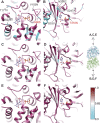Structural differences between yeast and mammalian microtubules revealed by cryo-EM
- PMID: 28652389
- PMCID: PMC5584162
- DOI: 10.1083/jcb.201612195
Structural differences between yeast and mammalian microtubules revealed by cryo-EM
Abstract
Microtubules are polymers of αβ-tubulin heterodimers essential for all eukaryotes. Despite sequence conservation, there are significant structural differences between microtubules assembled in vitro from mammalian or budding yeast tubulin. Yeast MTs were not observed to undergo compaction at the interdimer interface as seen for mammalian microtubules upon GTP hydrolysis. Lack of compaction might reflect slower GTP hydrolysis or a different degree of allosteric coupling in the lattice. The microtubule plus end-tracking protein Bim1 binds yeast microtubules both between αβ-tubulin heterodimers, as seen for other organisms, and within tubulin dimers, but binds mammalian tubulin only at interdimer contacts. At the concentrations used in cryo-electron microscopy, Bim1 causes the compaction of yeast microtubules and induces their rapid disassembly. Our studies demonstrate structural differences between yeast and mammalian microtubules that likely underlie their differing polymerization dynamics. These differences may reflect adaptations to the demands of different cell size or range of physiological growth temperatures.
© 2017 Howes et al.
Figures



Similar articles
-
Regulation of microtubule dynamics by Bim1 and Bik1, the budding yeast members of the EB1 and CLIP-170 families of plus-end tracking proteins.Mol Biol Cell. 2010 Jun 15;21(12):2013-23. doi: 10.1091/mbc.e10-02-0083. Epub 2010 Apr 14. Mol Biol Cell. 2010. PMID: 20392838 Free PMC article.
-
Structural transitions in the GTP cap visualized by cryo-electron microscopy of catalytically inactive microtubules.Proc Natl Acad Sci U S A. 2022 Jan 11;119(2):e2114994119. doi: 10.1073/pnas.2114994119. Proc Natl Acad Sci U S A. 2022. PMID: 34996871 Free PMC article.
-
Structural and functional differences between porcine brain and budding yeast microtubules.Cell Cycle. 2018;17(3):278-287. doi: 10.1080/15384101.2017.1415680. Epub 2018 Jan 30. Cell Cycle. 2018. PMID: 29278985 Free PMC article.
-
Tubulin rings: which way do they curve?Curr Opin Struct Biol. 2003 Apr;13(2):256-61. doi: 10.1016/s0959-440x(03)00029-0. Curr Opin Struct Biol. 2003. PMID: 12727521 Review.
-
Microtubules: an overview.Methods Mol Med. 2007;137:1-16. doi: 10.2119/molecular%20medicine-2006-00038. Methods Mol Med. 2007. PMID: 18085218 Review.
Cited by
-
Alternative Approaches to Understand Microtubule Cap Morphology and Function.ACS Omega. 2023 Jan 13;8(4):3540-3550. doi: 10.1021/acsomega.2c06926. eCollection 2023 Jan 31. ACS Omega. 2023. PMID: 36743020 Free PMC article. Review.
-
Functional genetics reveals modulators of anti-microtubule drug sensitivity.bioRxiv [Preprint]. 2024 Mar 13:2024.03.12.584469. doi: 10.1101/2024.03.12.584469. bioRxiv. 2024. Update in: J Cell Biol. 2025 Feb 3;224(2):e202403065. doi: 10.1083/jcb.202403065. PMID: 38559203 Free PMC article. Updated. Preprint.
-
Cryo-EM structure of cortical microtubules from human parasite Toxoplasma gondii identifies their microtubule inner proteins.Nat Commun. 2021 May 24;12(1):3065. doi: 10.1038/s41467-021-23351-1. Nat Commun. 2021. PMID: 34031406 Free PMC article.
-
Microtubule dynamics: an interplay of biochemistry and mechanics.Nat Rev Mol Cell Biol. 2018 Jul;19(7):451-463. doi: 10.1038/s41580-018-0009-y. Nat Rev Mol Cell Biol. 2018. PMID: 29674711 Free PMC article. Review.
-
Insights into allosteric control of microtubule dynamics from a buried β-tubulin mutation that causes faster growth and slower shrinkage.Protein Sci. 2020 Jun;29(6):1429-1439. doi: 10.1002/pro.3842. Epub 2020 Mar 9. Protein Sci. 2020. PMID: 32077153 Free PMC article.
References
Publication types
MeSH terms
Substances
Grants and funding
LinkOut - more resources
Full Text Sources
Other Literature Sources
Molecular Biology Databases

